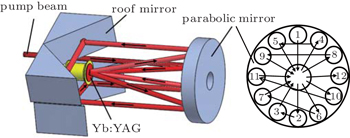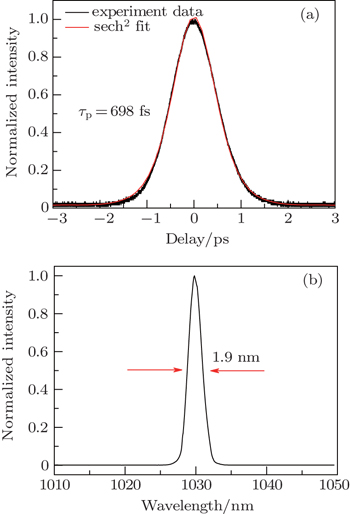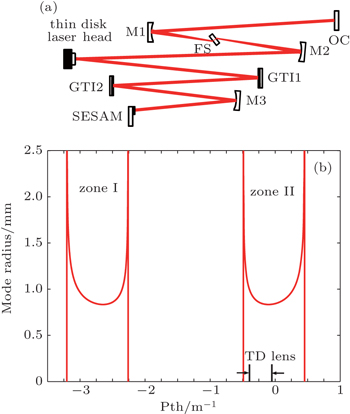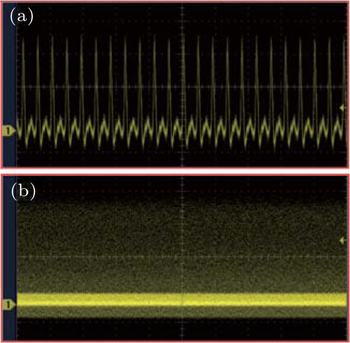† Corresponding author. E-mail:
Project supported by the National Key Basic Research Program of China (Grant No. 2013CB922402), the National Major Instrument Program of China (Grant No. 2012YQ120047), and the National Natural Science Foundation of China (Grant No. 61210017).
Pumped by a 940 nm fiber-coupled diode laser, a passively mode-locked Yb:YAG thin disk oscillator was demonstrated with a semiconductor saturable absorber mirror (SESAM). 12.1 W mode-locked pulses were obtained with pulse duration of 698 fs at the repetition rate of 57.43 MHz. Measurement showed that the beam quality was close to the diffraction limit.
Ultrafast lasers providing high average powers have become a promising tool for scientific research and industrial applications, such as strong-field physics, nonlinear wavelength conversion, and high-speed and high-precision micromachining. Up to now, watt-level femtosecond oscillators have been demonstrated based on bulk gain media such as Yb:KGW,[1] Yb:CaF2,[2] and Yb:YAG ceramics.[3] However, the increasing of the output power is limited by the thermal effect in the bulk ceramics and crystals. The rise of the temperature is a crucial problem for the bulk gain media to generate ultrafast pulses with high average power and good beam quality. In addition, the thermal lens effect is detrimental on quasi-three-level systems to obtain the highest power efficiency under high pump-power densities. To improve the thermal management of the gain media, many new techniques, such as thin disk, fiber,[4,5] and slab[6] systems, have appeared, and by using those techniques, the power has been successfully increased to the hundred-watt level.[7–9] Compared with the other two geometries, the thin disk structure is of more benefit to obtaining kilowatt power by increasing the pump diameter or by using several crystal disks.[10]
In contrast to the bulk oscillators, the thin disk concept[10,11] is based on a thin (≈ 200 μm) and large diameter (> 5 mm) gain medium, one of whose surfaces is directly mounted on a water-cooled heat sink. Because of the large ratio between the diameter and the thickness of the disk, the heat flow along the beam axis is nearly one-dimensional, which leads to small thermal distortions and aberrations even at very high pump power. The thin disk oscillators allow both high power and good beam quality because of their excellent heat removal capabilities. Combining with the passively mode-locked technique, the thin disk concept provides an approach to achieve high-power ultrafast pulses without additional amplifier stages. In 2000, Aus der Au et al. demonstrated a passively mode-locked Yb:YAG thin disk laser with an output power of 16.2 W for the first time.[12] Now this technique has stepped into the average power and pulse energy frontiers obtained from ultrafast oscillators. Average power up to 275 W,[9] shortest pulse duration of 730 fs[12] (in atmospheric air), and pulse energy of 80 μJ[13] were demonstrated using semiconductor saturable absorber mirror (SESAM) mode-locked Yb:YAG thin disk oscillators. Pronin et al obtained 200-fs pulses from a Kerr-lens mode-locked Yb:YAG thin disk oscillator with an average power of 17 W.[14] SESAM-mode-locked thin disk lasers (TDLs) currently achieve higher pulse energies and average powers than any other ultrafast oscillator technology. Along with the development of the thin disk technology, many different crystals have been proved to be potential candidates for thin disk gain materials, such as Yb:LuScO,[15–17] Yb-doped cubic sesquioxides,[18–20] tungstate materials,[21,22] and Yb:YCOB.[23]
It is noticeable that Yb:YAG is widely used as the thin disk crystal because it can be grown with high quality and in large sizes. In addition, it is characterized by good thermal conductivity (∼ 7 W/(m·K)) and wide absorption and emission bands, which are necessary factors to generate high average power. In this work, we demonstrated a compact passively mode-locked femtosecond Yb:YAG thin disk oscillator by SESAM. In order to increase the nonlinearity in the cavity, a 2-mm-thick Brewster plate was positioned at the focus point of two concave mirrors, whose radii of curvature are 150 mm and 200 mm, respectively. By using this asymmetrical and tight focus cavity structure, large laser mode on the thin disk and compact cavity design were obtained at the same time.[24] This asymmetrical cavity design makes it possible to obtain a high repetition rate by using the thin disk laser. High repetition rate and high power ultrafast lasers are good tools for UV-XUV and MIR frequency comb spectroscopy. By optimizing the cavity, 12.1 W average output power of 698-fs pulses was obtained under the pump power of 55 W with an optical-to-optical efficiency of 22%.
In the experiment, a 220-μm-thick 7 at.% doped Yb:YAG disk was used as the gain medium. One surface of the thin Yb:YAG disk coated for high reflectivity at both the laser and the pump wavelengths was directly mounted on a water-cooled heat sink, and the other surface had an antireflection coating. A fiber-coupled laser diode (LD) emitting at 940 nm with an output power of 70 W was used as the pump source. The pump laser spot aligned on the disk has a diameter of 2.3 mm, which is much larger than the thickness (220 μm) of the crystal. To avoid the damage caused by residual reflections of the pump power from the antireflection coating, the disk was slightly wedged. Due to the very small thickness of the disk, the single-pass pump absorption is limited to a few percent (of the order of 10%) at the typical doping level. In order to overcome this limitation, a multiple pump pass arrangement should be used. Figure
 | Fig. 1. Pump design for 24 absorption passes. The sequence of the segments on the parabolic mirror used as the pump laser traverses through the setup is indicated by numbers 1–12. |
Figure
The thermal lens seems to be the most crucial limitation for high power operation. This problem is partly solved by using a thin disk gain medium. The influence of the thermal lens on the resonator mode and stability was demonstrated by Magni.[25] We analyzed the mode radius on the disk under the influence of the dioptric power of the thermal lens. The ABCD analysis of this cavity (Fig.
For soliton mode-locking, a 2-mm-thick fused silica plate was positioned at the focus point of two curved mirrors with Brewster angle to introduce the self-phase modulation (SPM) and to achieve the linear polarization of the laser mode. Two Gires–Tournois interferometer mirrors, generating a total negative GDD of 4000 fs2 per round trip, balanced the SPM phase shift. Another curved mirror with a radius of curvature of 500 mm in the cavity was used to increase the fluence on the SESAM. For starting and stabilizing the mode-locking, a SESAM (BATOP GmbH) with 1 ps relaxation time and < 0.7% modulation depth was used in the experiment. The laser mode radius on the SESAM is calculated to be ≈ 150 μm.
To carry out the experiment, we first used a high reflection mirror to align the laser cavity. With a 2.5%-transmission output coupler, we obtained the maximum CW average power up to 25.2 W with a fundamental laser mode, corresponding to an optical-to-optical efficiency of 35.2%. Then a stable mode locking operation was obtained by replacing the high reflection mirror with a SESAM. The average power of the mode-locked pulses in single mode operation (M2 < 1.1) could rise from 4.77 W to 12.1 W by increasing the pump power, corresponding to a slope efficiency of 35%. Figure
 | Fig. 3. (a) The variation of output power with pump power. (b) The M2 factors and the beam profile (inset) of mode-locked operation. |
The beam quality of the mode-locked operation at the average power of 12.1 W was measured by a commercial M2 factor meter (Spiricon M2-200s), as released in Fig.
The stable mode-locked pulse train is shown in Fig.
 | Fig. 5. (a) Pulse duration of the SESAM mode-locked Yb:YAG thin disk oscillator. (b) The corresponding laser spectrum. |
The radio frequency (RF) of the mode-locked pulses was measured with an RF spectrum analyzer (Agilent E4407B). As shown in Fig.
In our experiment, a crucial issue for high power operation was the damage to the SESAM. The damage was always caused by the mode-locking instability and the corresponding high peak intensity during the pulse build-up process. In addition, the low damage threshold (∼ 4 mJ/cm2) was another important reason for easy damage in high power operation. Relevant study showed that the damage at high fluences occurs due to heating of the lattice by the inverse saturable absorption (ISA), rather than the specific design of the absorber section.[26] So high power TDLs require the SESAMs with high damage threshold, large saturation fluencies, and reduced ISA. By using multiple QWs and a suitable dielectric topsection, the SESAMs with < 0.1% nonsaturable losses and reduced ISA could withstand pulse fluences > 0.2 J/cm2.[27] With high damage threshold SESAM, kilowatt mode-locking thin disk oscillators would be obtained by power scaling. In our experiment, to obtain higher output power, we should optimize the starting regime of the oscillator and enlarge the laser mode on the SESAM. In the future, high pump power will be used to generate higher average power by enlarging the mode size both on the thin disk and the SESAM.
We presented a stable passively mode-locked Yb:YAG thin disk oscillator with a SESAM. An average output power as high as 12.1 W with 698 fs pulse duration was obtained at a repetition rate of 57.43 MHz. The central wavelength was 1030 nm with a spectral bandwidth of 1.9 nm. Near single fundamental mode with beam quality of M2 < 1.1 was realized. The Yb:YAG thin disk oscillator will be a potential candidate for high power and good beam quality laser source.
| 1 | |
| 2 | |
| 3 | |
| 4 | |
| 5 | |
| 6 | |
| 7 | |
| 8 | |
| 9 | |
| 10 | |
| 11 | |
| 12 | |
| 13 | |
| 14 | |
| 15 | |
| 16 | |
| 17 | |
| 18 | |
| 19 | |
| 20 | |
| 21 | |
| 22 | |
| 23 | |
| 24 | |
| 25 | |
| 26 | |
| 27 |





